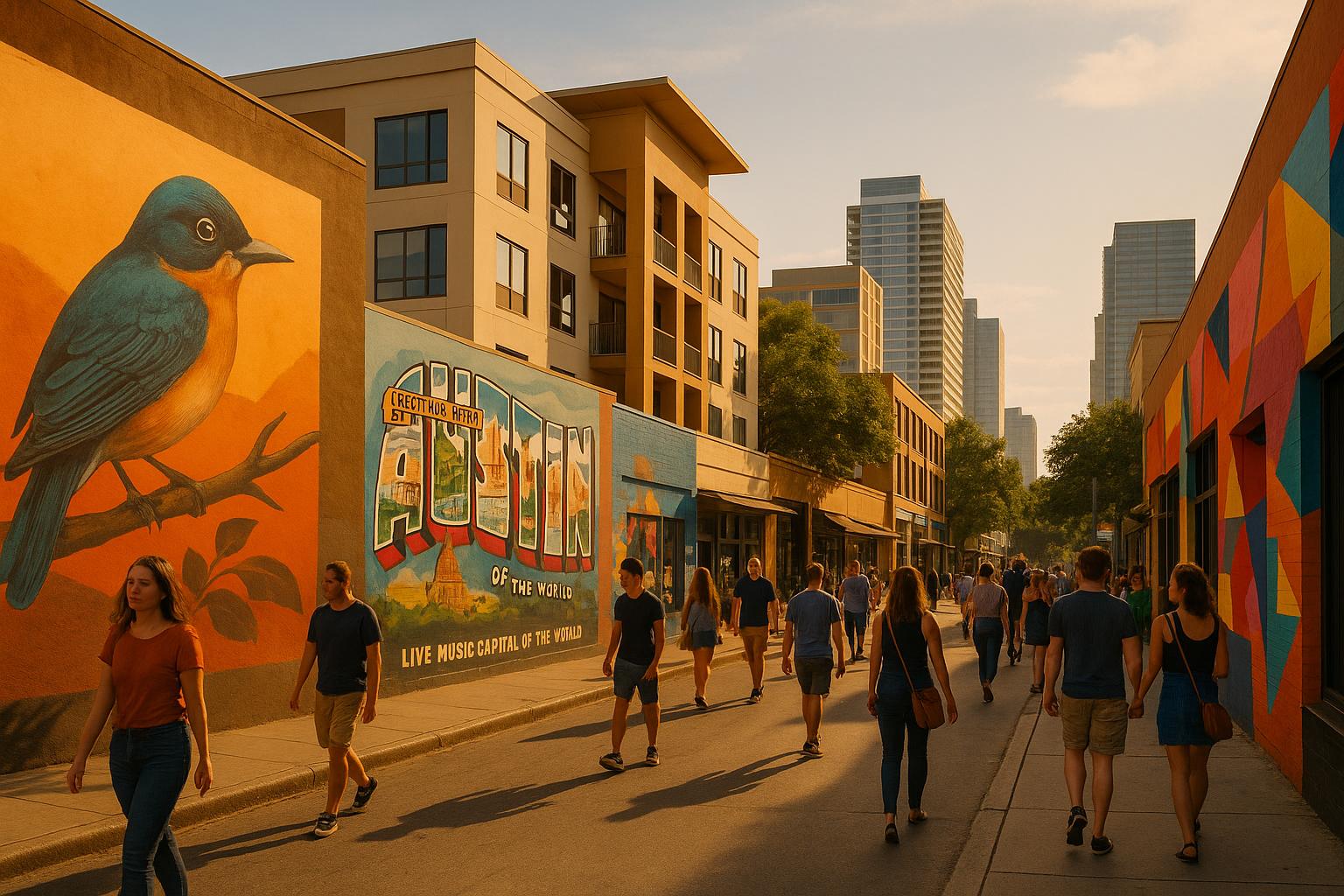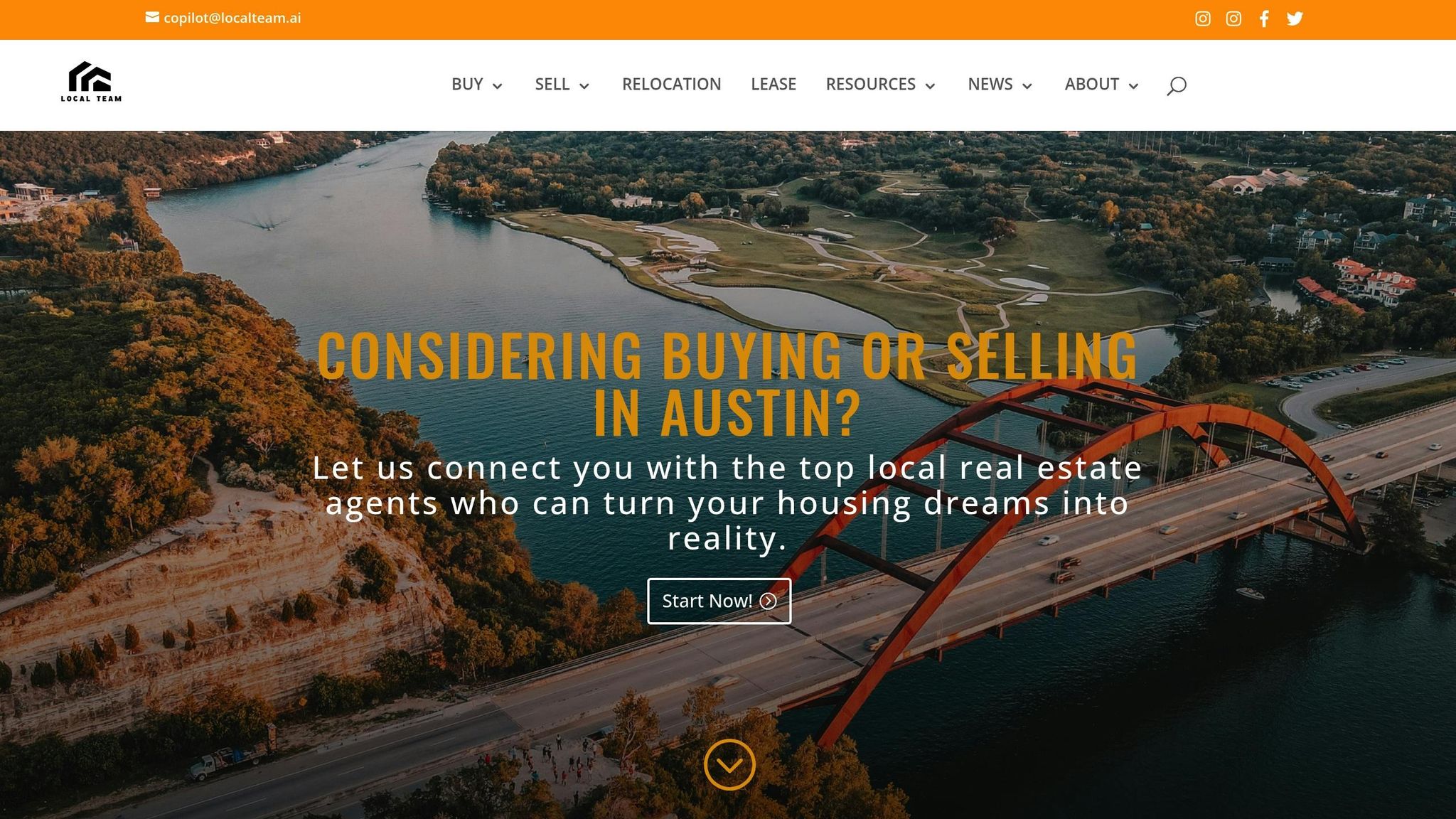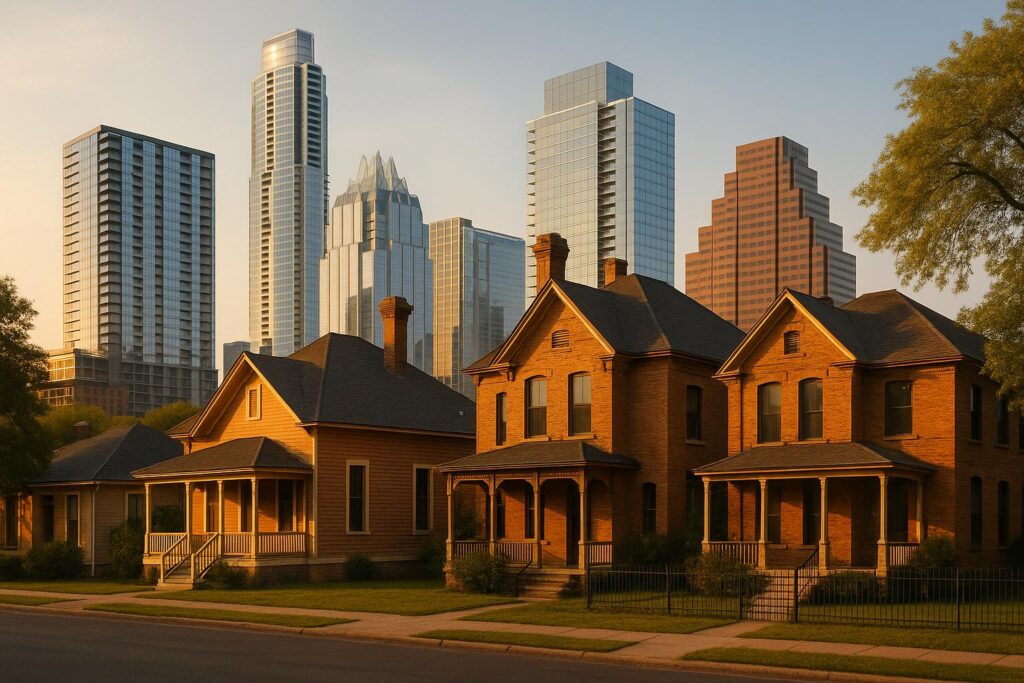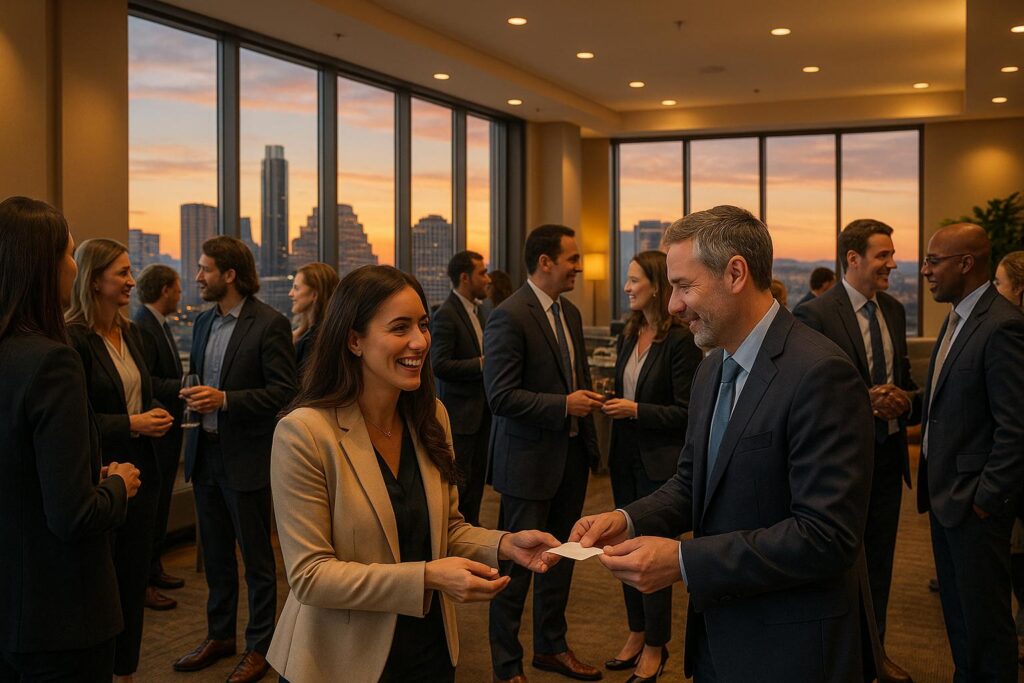Austin’s arts and music scene is reshaping its real estate market. Events like SXSW and Austin City Limits attract visitors who often decide to stay, fueling demand for homes near arts hubs. Neighborhoods like the Red River Cultural District, East Austin, and South Congress are thriving, with rising property values and strong interest from buyers and investors. The city’s tech growth, combined with its vibrant arts offerings, creates opportunities for real estate development, short-term rentals, and community investment.
Key takeaways:
- Home prices surged: Median price hit $608,438 by May 2024, up 11.6% from the previous year.
- Neighborhoods near arts venues: Areas with galleries, music spots, and murals see higher demand and prices.
- Short-term rentals thrive: Seasonal events drive rental income spikes.
- Infrastructure improvements: Upgrades around arts hubs enhance property appeal.
Understanding the connection between arts tourism and real estate demand can help buyers, sellers, and investors make informed decisions in Austin’s dynamic market.
South Congress Austin | Neighborhood Tour
Arts Tourism as a Driver for Real Estate Development
Austin’s vibrant arts scene is reshaping neighborhoods, sparking new developments, and driving up property values.
Key Arts Drivers in Austin
Austin’s music festivals are a powerhouse, drawing massive crowds and fueling interest in the local housing market. These events not only sustain seasonal demand but also entice visitors to consider the city as a long-term home.
The Red River Cultural District stands out as a prime example. With its mix of iconic music venues and local eateries, this area has become a magnet for both tourists and potential homebuyers. Properties near such cultural hubs often come with a price premium, reflecting their added appeal.
Austin’s mural scene also plays a transformative role. Eye-catching public artworks, like the mural on South Lamar, contribute to the unique character of neighborhoods and draw attention from prospective residents. These artistic landmarks, combined with emerging art destinations, make certain areas particularly desirable.
Adding to this cultural fabric is Austin’s thriving food scene. Neighborhoods blending artistic and culinary experiences create a lifestyle that many find irresistible. Together, these artistic and gastronomic elements boost neighborhood allure and, in turn, raise property values.
Impact on Neighborhood Appeal
Cultural venues have a direct impact on neighborhood desirability. Homes located near these hotspots benefit from increased walkability, convenience, and a lively community vibe, which all contribute to higher property values.
This appeal often motivates residents to invest in home improvements, further driving demand in these areas. A sense of safety and the vibrant atmosphere of art-centric neighborhoods also enhance their attractiveness, making them sought-after places to live.
Tourism’s Role in Commercial and Residential Development
As cultural attractions reshape neighborhoods, they also influence the direction of real estate development. Urban areas that embrace art see strong leasing activity and elevated rental rates, reflecting their growing demand.
Short-term rental properties near cultural venues thrive as well, especially during major festivals, when rentals see a seasonal surge. This creates appealing opportunities for investors looking to capitalize on the city’s arts tourism.
Luxury housing developments are also tapping into this trend. Many now feature arts-focused amenities, such as gallery spaces or community event areas, catering to buyers who value a culturally rich lifestyle. On the commercial side, businesses near cultural hubs benefit from increased foot traffic and extended operating hours, making these areas even more economically attractive.
City investments in infrastructure, such as better lighting, improved sidewalks, and enhanced public transportation around cultural destinations, add to the appeal. These upgrades not only boost property desirability but also strengthen the connection between arts tourism and real estate development. This interplay between culture and development sets the stage for broader economic impacts, which will be explored further in the next section.
Economic Impacts of Arts Tourism on Austin’s Real Estate Market
Austin’s cultural attractions are doing more than just drawing in tourists – they’re reshaping neighborhoods and leaving a noticeable mark on the real estate market. While hard numbers directly tying arts tourism to property values are scarce, local real estate professionals consistently point out that neighborhoods with rich cultural offerings often see a boost in desirability among both buyers and renters.
Property Value Trends Near Arts Attractions
Proximity to cultural venues appears to bring a clear advantage when it comes to property values. Real estate experts in Austin highlight how arts-focused neighborhoods often stand out due to their unique lifestyle appeal. While exact figures are elusive, these areas tend to show stronger growth in value compared to more traditional residential markets.
Boost to Rental and Hospitality Markets
The impact of arts tourism isn’t limited to home sales – it also ripples through the rental market. Neighborhoods near cultural hotspots attract a diverse crowd, including young professionals and creatives, driving demand for rental properties. Seasonal events and festivals often lead to temporary spikes in rental income, and the rising popularity of short-term rentals and boutique accommodations has opened up new opportunities for property owners looking to capitalize on Austin’s vibrant arts scene.
Broader Economic Benefits
The influence of arts tourism extends beyond real estate. It fuels local businesses – restaurants, shops, and entertainment venues thrive as visitors flock to the area. This steady stream of economic activity not only supports job creation but also encourages further investment in the community. The result? A more dynamic and resilient local economy that continues to attract homeowners and investors alike. Arts tourism, in many ways, has become a cornerstone of Austin’s ongoing real estate expansion.
sbb-itb-4c99469
Neighborhood Spotlights: Arts Tourism’s Impact on Local Areas
Beyond its broader economic effects, arts tourism has a noticeable influence on specific neighborhoods. In Austin, this impact is particularly evident in how it shapes real estate opportunities and community development.
Downtown Austin: The Heart of Arts Activity
Downtown Austin stands out as a vibrant cultural hub, packed with performance venues, galleries, and creative spaces. This artistic energy has played a significant role in transforming the real estate landscape. The area has experienced a surge in mixed-use developments and high-end residential projects, such as upscale condominiums and modern office spaces. These developments not only reflect Austin’s creative vibe but also attract forward-thinking businesses and residents eager to be part of this dynamic atmosphere.
East Austin: A Hub for Art and Revitalization
East Austin offers a compelling example of cultural renewal fueled by the arts. The neighborhood has cultivated a distinct identity through a mix of art venues, music spaces, and community-driven projects. This creative revival has sparked the adaptive reuse of older industrial buildings, turning them into stylish lofts and apartments. At the same time, new residential developments have emerged to cater to the influx of creative professionals. Commercial spaces are also evolving to support the needs of the growing creative industries and the bustling rental market. This transformation highlights how arts tourism can breathe new life into a neighborhood while boosting real estate demand.
South Congress: Popular Attractions and Housing Demand
Known locally as "SoCo", South Congress Avenue has become one of Austin’s most iconic cultural hotspots. Its blend of boutique stores, music venues, and landmarks draws a constant stream of visitors, making it a magnet for both tourists and locals. This popularity has fueled a rise in both residential and commercial development, further solidifying the area’s reputation as a cultural and economic powerhouse.
These neighborhoods illustrate how arts tourism serves as a driving force behind Austin’s evolving real estate market, shaping communities and creating opportunities for growth.
Making the Most of Opportunities: Using Arts Tourism for Real Estate Success
Austin’s vibrant arts scene offers unique opportunities for smart real estate decisions. Whether you’re purchasing your first home, selling a property, or growing an investment portfolio, understanding how cultural tourism influences the market can lead to better outcomes. Tapping into this knowledge allows you to make informed choices and maximize returns.
Investment Strategies for Buyers and Sellers
Buyers should focus on properties near prominent arts venues. Homes in or around arts districts tend to appreciate faster and hold their value better. Look for neighborhoods with multiple cultural attractions, as they create steady, long-term demand.
When evaluating a property, consider its walkability to key arts destinations. For example, homes near the Red River Cultural District or within walking distance of venues like the Paramount Theatre often command higher prices and are more resilient during market fluctuations. Emerging arts districts are also worth exploring for their potential to see significant appreciation over time.
Sellers can highlight their property’s cultural connections to attract more interest. Showcase nearby galleries, music venues, and upcoming arts-related developments to make your home stand out. Timing your listing around major cultural events, like South by Southwest or the Austin City Limits Music Festival, can also boost visibility and attract buyers who are caught up in the energy of the area.
For investment buyers, areas undergoing arts-driven revitalization are excellent targets. These neighborhoods often experience rising property values, but it’s essential to research local zoning laws and development plans to ensure sustainable growth.
How Austin Local Team Can Help
Navigating these strategies becomes simpler with the support of local expertise. Austin Local Team offers tools and services tailored to the intersection of real estate and cultural tourism.
Their personalized agent matchmaking service connects you with professionals who understand how proximity to arts venues impacts property values and neighborhood dynamics. This ensures you’re working with someone who knows Austin’s unique market inside and out.
For data-driven decisions, the platform’s comparative market analysis tools provide insights into how cultural landmarks influence property prices in specific areas. Whether you’re eyeing a home near the Austin Convention Center or selling in the Warehouse District, these tools take the guesswork out of valuation.
Austin Local Team’s home search tools allow you to filter properties based on their closeness to cultural attractions like theaters, galleries, and music venues. This saves time and ensures you’re focusing on properties that align with your lifestyle or investment goals.
For newcomers relocating to Austin for its arts scene, the platform offers relocation assistance. This includes guidance on how different neighborhoods engage with the city’s cultural ecosystem, helping you find the perfect balance between artistic access and real estate value.
Additionally, the platform provides ongoing market insights to track how cultural developments – like new venue openings or arts district expansions – affect local real estate trends. This information helps both buyers and sellers make well-timed decisions.
Navigating the Market with Local Expertise
Austin’s real estate market moves quickly, and the added layer of cultural tourism requires specialized knowledge. Local experts understand the rhythms of arts events and can guide you on the best times to make a purchase or list a property.
Their familiarity with off-market opportunities and arts-adjacent neighborhoods gives you an edge in securing the right deal. This expertise is especially helpful when evaluating mixed-use developments that combine residential and cultural spaces. These projects demand insight into both real estate fundamentals and arts programming to determine their long-term appeal.
Understanding zoning regulations in Austin’s cultural districts is another area where local knowledge is crucial. Certain areas have rules designed to preserve their artistic character or support cultural uses, which can impact development potential and property value over time.
Conclusion: Arts Tourism as a Foundation of Austin’s Real Estate Boom
Austin’s thriving arts and cultural scene plays a major role in driving the city’s booming real estate market. This unique blend of creativity and commerce benefits homeowners, investors, and the broader community, creating ripple effects throughout the local economy.
High-profile events like South by Southwest and Austin City Limits have a direct impact on housing demand and property values, especially in neighborhoods near event venues. These festivals and cultural happenings attract a diverse crowd of artists, innovators, and enthusiasts, adding energy and character to the city’s neighborhoods.
Cultural development has also revitalized areas like the Red River Cultural District, East Austin, and South Congress. These once-overlooked neighborhoods have transformed into sought-after locales, showcasing how arts and cultural attractions can breathe new life into communities.
The tech boom in Silicon Hills further fuels this dynamic. Tech companies often use Austin’s vibrant cultural scene as a selling point to attract top talent, which, in turn, drives up housing demand. Homes near cultural hubs not only hold their value but also demonstrate strong market resilience, making them a smart investment.
At its core, Austin’s real estate success is deeply tied to its rich cultural fabric. As the city continues to evolve, its arts and culture remain a cornerstone of its growth, shaping a real estate market that’s as dynamic as the city itself.
FAQs
How does cultural tourism influence property values in Austin neighborhoods like the Red River Cultural District and East Austin?
Cultural tourism has a noticeable impact on property values in Austin neighborhoods like the Red River Cultural District and East Austin. These areas are magnets for visitors, thanks to their lively music venues, art galleries, and diverse dining options. This steady influx of tourists not only energizes local businesses but also enhances the neighborhoods’ overall appeal, making them attractive to both residents and real estate investors.
As tourism fuels economic activity and amplifies the charm of these districts, the demand for housing naturally rises. This often results in increasing property values. On top of that, city-backed initiatives and funding aimed at nurturing these cultural hubs add to their growth and long-term potential in the real estate market. For buyers and investors seeking opportunities in Austin’s booming cultural tourism scene, these neighborhoods stand out as promising choices.
Why are neighborhoods near cultural venues in Austin so appealing to real estate investors?
Neighborhoods surrounding Austin’s cultural hotspots have become a magnet for real estate investors, thanks to the surge in property values fueled by cultural tourism. Festivals, artistic hubs, and popular events not only attract visitors but also entice new residents to move in, creating a steady demand for housing.
On top of that, the draw of cultural activities brings both tourists and locals into the area, boosting the local economy. This economic activity translates into higher rental demand and consistent property value growth, making these neighborhoods an appealing choice for investment.
How can homebuyers use Austin’s arts and culture scene to guide their real estate choices?
Homebuyers looking to immerse themselves in Austin’s lively arts scene should consider neighborhoods like Bouldin Creek or East Austin. These areas are buzzing with creative energy, foster a strong sense of community, and offer a distinctive character that often enhances property values over time.
With features like galleries, music venues, and festivals, these neighborhoods tend to draw high demand and show promising growth potential. Choosing a home in such vibrant areas not only complements an arts-focused lifestyle but can also be a savvy investment in Austin’s ever-evolving real estate market.






